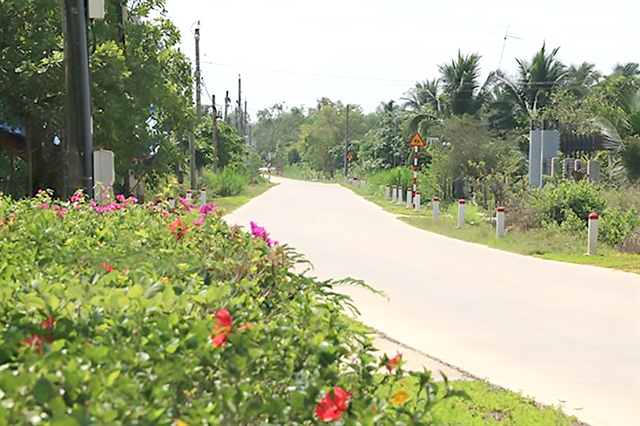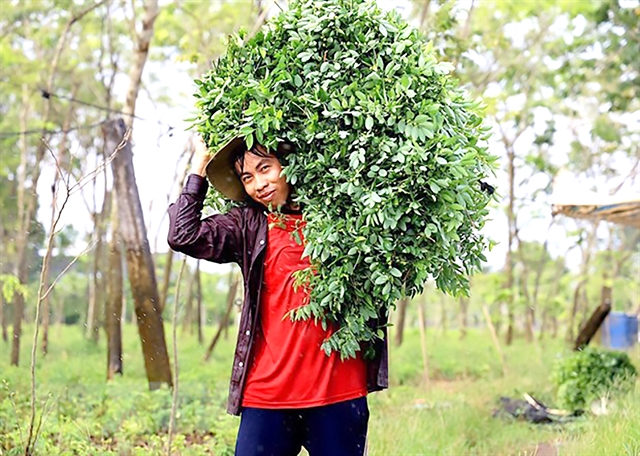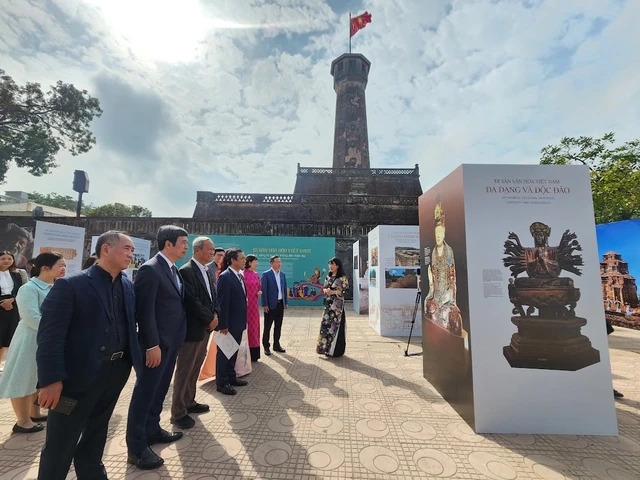 Society
Society

 |
| A beautiful road with flowers and trees in Gia Canh Commune, Định Quán District. — VNA/VNS Photo Sỹ Tuyên |
ĐỒNG NAI — During the past ten years, Đồng Nai has led the way in building a new rural lifestyle across the country.
The southern province’s rural area has gradually changed, shortening the economic and infrastructure gap between urban and rural areas.
Achievements
The way from Biên Hòa City, the administrative centre of Đồng Nai, to the rural area has changed a lot. Rural roads are concreted, with flowers planted by local people and commune authorities. They are also beautifully decorated with trees.
Đoàn Văn Thiện, chairman of the Lang Minh Commune People’s Committee in Xuân Lộc District, said that to create a landscape that helps people enjoy the true beauty of the countryside, the committee implemented a programme to plant lotus on the main road to the commune.
Now Lang Minh Commune has had obvious changes. Although it was originally an agricultural commune, people now use their orchards for economic development through rural tourism and ecotourism.
Cao Tiến Sỹ, director of the Đồng Nai Department of Agriculture and Rural Development, said that the province had achieved important achievements in all aspects.
The province’s rural area has a clear change, and innovation and production have developed stably. As a result, socio-economic infrastructure develops comprehensively, whereas the school system meets national standards.
It also has standard medical stations and a stable electricity system. The ecological environment has improved step by step. Security and political order are maintained.
The average income in rural areas in 2020 was VNĐ61.75 million (US$2,400) per person per year, three times higher than in 2010.
The rate of poor households decreased sharply from 6.22 per cent in 2010 to only 0.04 per cent now.
Đồng Nai Province is one of the first two localities in the country to be recognised by the Prime Minister for completing the task of building a new rural lifestyle.
It is one of four provinces selected by the Government to pilot a model new rural district in Xuân Lộc.
Important role
Đồng Nai Province always defines people as playing the most important role in building a new rural lifestyle.
Lê Hữu Thiện, deputy chairman of the provincial Farmers’ Association, said that local farmers had actively responded to the emulation campaign to develop products and get rich, especially to support disadvantaged households.
Last year, the association called for sponsors to support more than VNĐ29 billion ($1.2 million), 11 tonnes of fertiliser, more than 6,500 litres of plant protection substances, nearly 154.4 tonnes of food and almost 8.3 tonnes of seeds to help 2,000 disadvantaged households.
Farmers are the main force in building a new rural lifestyle.
They also help preserve and maintain the roads and facilities in the countryside.
Farmers are participants in maintaining order and security in rural areas. In addition, each family contributed to building a good cultural and spiritual life, said Thiện.
Nguyễn Thị Bích Lệ, director of the Trường Phát Agricultural Service Cooperative in Nhơn Trạch District, said that the new rural construction programme created more favourable conditions for cooperatives to develop production.
Her cooperative has built a raw material area of 70 hectares for growing lotus, with 13 different products from lotus.
Market development
 |
| A farmer is happy with the good agricultural products in Lang Minh Commune, Xuân Lộc District. — VNA/VNS Photo Hồng Đạt |
In the rural infrastructure, investment in commercial infrastructure, especially building linkages from production to consumption for more sustainable agricultural products’ output, is one of the important contents in developing new rural areas in the province.
Đặng Trần Nhật Thoại, deputy director of the Trade Management Division under the Đồng Nai Department of Industry and Trade, said that the Ministry of Industry and Trade had issued Decision No 1214/QĐ-BCT on recognition of rural commercial infrastructure meeting standards for the period 2021-25.
This guide stipulates criteria for assessing and recognising communes meeting rural commercial infrastructure standards, including rural markets, mini supermarkets, shops or general businesses.
Fresh food stores and service areas must be arranged separately to ensure food safety conditions. In addition, the markets must have clean water.
To encourage enterprises to invest in rural markets, Đồng Nai has many incentives and support policies, such as land rent exemption and reduction, investment credit support, and creating conditions for businesses to conduct science and technology transfer and workforce training.
Nguyễn Thị Cát Tiên, chairwoman of the Xuân Lộc District People’s Committee, said that the district had more than 100 production areas, more than 220 farms with nine key agricultural products.
The goal is that by 2025, each commune will have at least two models of agricultural products applying high technology and produced on a large scale.
Model residential areas
Along with developing rural markets, Đồng Nai Province also focuses on building model residential areas and creating a good lifestyle in rural areas.
A representative from the Đồng Nai Department of Agriculture and Rural Development said that localities registered to build 20 model residential areas this year.
Up to now, 14 were recognised as model residential areas.
Huỳnh Thị Tuyết San lives in Village 4, Lâm San Commune, Cẩm Mỹ District, which is one of the model residential areas.
She said local officials were very enthusiastic about working with people to set up model residential areas.
Thanks to that, people in the residential area are actively involved in cleaning the living environment, planting flowers and trees, and always keeping the landscape clean and beautiful.
Lê Quốc Việt, a resident of Xuân Thanh Ward, Long Khánh City, spends a lot of time taking care of flowers and ornamental plants in his garden.
He also collected many strange trees and flowers planted outside the fence in front of his house, contributing to the beauty of the street in the residential area.
Việt said local people buy trees and flowers together to form bright, green, clean, beautiful roads.
Another good example is Village 1, Bình Lộc Commune in Long Khánh District.
The village has a total area of 34ha with more than 400 households and 1,900 people.
It is one of the localities that thrive on ecotourism.
People not only pay attention and care to having bright, green, clean and beautiful flowers and trees. They also pay great attention to building model gardens to become an ideal destination to attract tourists. — VNS




